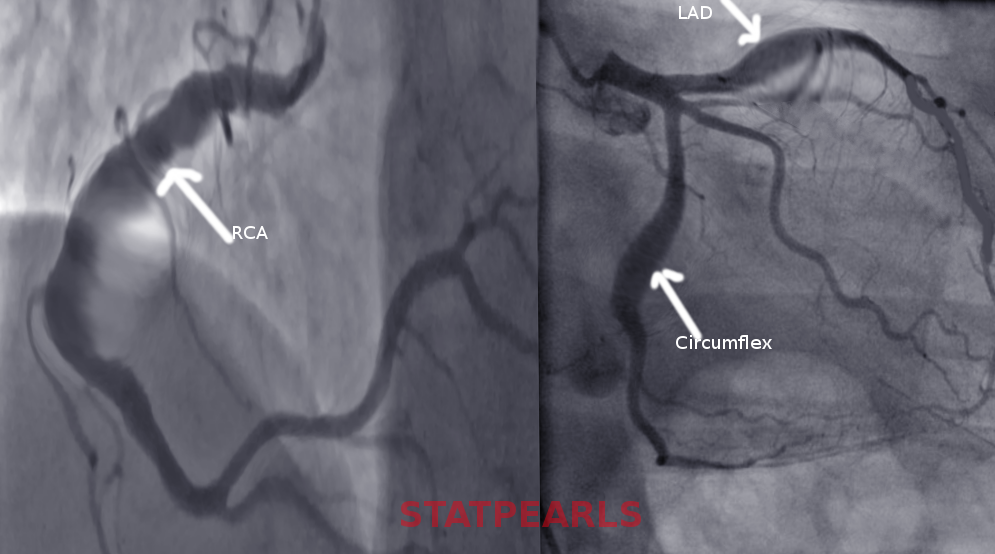[1]
Mavrogeni S. Coronary artery ectasia: from diagnosis to treatment. Hellenic journal of cardiology : HJC = Hellenike kardiologike epitheorese. 2010 Mar-Apr:51(2):158-63
[PubMed PMID: 20378518]
[2]
Zeina AR, Sharif D, Blinder J, Rosenschein U, Barmeir E. Noninvasive assessment of coronary artery ectasia using multidetector computed tomography. Coronary artery disease. 2007 May:18(3):175-80
[PubMed PMID: 17429290]
[3]
Díaz-Zamudio M, Bacilio-Pérez U, Herrera-Zarza MC, Meave-González A, Alexanderson-Rosas E, Zambrana-Balta GF, Kimura-Hayama ET. Coronary artery aneurysms and ectasia: role of coronary CT angiography. Radiographics : a review publication of the Radiological Society of North America, Inc. 2009 Nov:29(7):1939-54. doi: 10.1148/rg.297095048. Epub
[PubMed PMID: 19926755]
[4]
Swaye PS, Fisher LD, Litwin P, Vignola PA, Judkins MP, Kemp HG, Mudd JG, Gosselin AJ. Aneurysmal coronary artery disease. Circulation. 1983 Jan:67(1):134-8
[PubMed PMID: 6847792]
[5]
Antoniadis AP, Chatzizisis YS, Giannoglou GD. Pathogenetic mechanisms of coronary ectasia. International journal of cardiology. 2008 Nov 28:130(3):335-43. doi: 10.1016/j.ijcard.2008.05.071. Epub 2008 Aug 9
[PubMed PMID: 18694609]
[6]
Manginas A, Cokkinos DV. Coronary artery ectasias: imaging, functional assessment and clinical implications. European heart journal. 2006 May:27(9):1026-31
[PubMed PMID: 16415301]
[7]
Sayin T, Döven O, Berkalp B, Akyürek O, Güleç S, Oral D. Exercise-induced myocardial ischemia in patients with coronary artery ectasia without obstructive coronary artery disease. International journal of cardiology. 2001 Apr:78(2):143-9
[PubMed PMID: 11334658]
[8]
Zografos TA, Korovesis S, Giazitzoglou E, Kokladi M, Venetsanakos I, Paxinos G, Fragakis N, Katritsis DG. Clinical and angiographic characteristics of patients with coronary artery ectasia. International journal of cardiology. 2013 Aug 20:167(4):1536-41. doi: 10.1016/j.ijcard.2012.04.098. Epub 2012 May 8
[PubMed PMID: 22572634]
[9]
Turhan H, Yetkin E. What is the plausible strategy for the management of patients with isolated coronary artery ectasia and myocardial ischemia? International journal of cardiology. 2007 Apr 25:117(2):285-6
[PubMed PMID: 16893580]
[10]
Levine GN, Bates ER, Blankenship JC, Bailey SR, Bittl JA, Cercek B, Chambers CE, Ellis SG, Guyton RA, Hollenberg SM, Khot UN, Lange RA, Mauri L, Mehran R, Moussa ID, Mukherjee D, Nallamothu BK, Ting HH. 2011 ACCF/AHA/SCAI Guideline for Percutaneous Coronary Intervention: a report of the American College of Cardiology Foundation/American Heart Association Task Force on Practice Guidelines and the Society for Cardiovascular Angiography and Interventions. Circulation. 2011 Dec 6:124(23):e574-651. doi: 10.1161/CIR.0b013e31823ba622. Epub 2011 Nov 7
[PubMed PMID: 22064601]
Level 1 (high-level) evidence
[11]
Gulec S, Atmaca Y, Kilickap M, Akyürek O, Aras O, Oral D. Angiographic assessment of myocardial perfusion in patients with isolated coronary artery ectasia. The American journal of cardiology. 2003 Apr 15:91(8):996-9, A7
[PubMed PMID: 12686347]
[12]
Ullah W, Shaukat M, Ahmad A, Ali Z, Mukhtar M, Ur Rashid M. A giant coronary artery ectasia successfully managed conservatively. Journal of community hospital internal medicine perspectives. 2020 Aug 2:10(4):343-345. doi: 10.1080/20009666.2020.1773710. Epub 2020 Aug 2
[PubMed PMID: 32850094]
Level 3 (low-level) evidence
[13]
Fan CH, Hao Y, Liu YH, Li XL, Huang ZH, Luo Y, Li RL. Anti-inflammatory effects of rosuvastatin treatment on coronary artery ectasia patients of different age groups. BMC cardiovascular disorders. 2020 Jul 11:20(1):330. doi: 10.1186/s12872-020-01604-z. Epub 2020 Jul 11
[PubMed PMID: 32652935]

